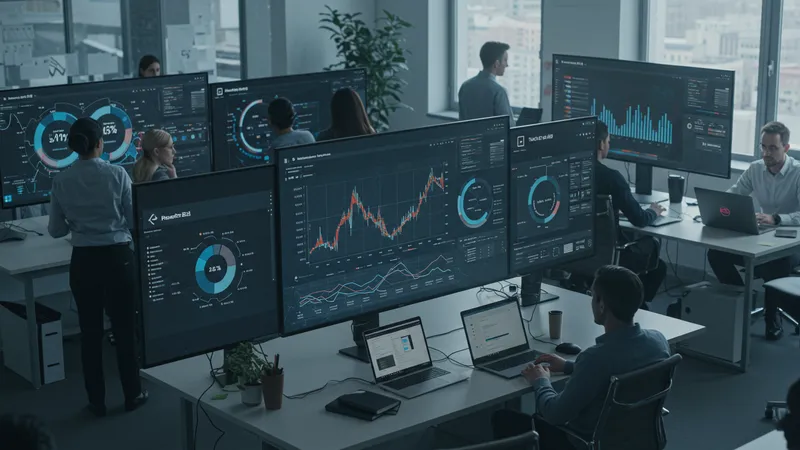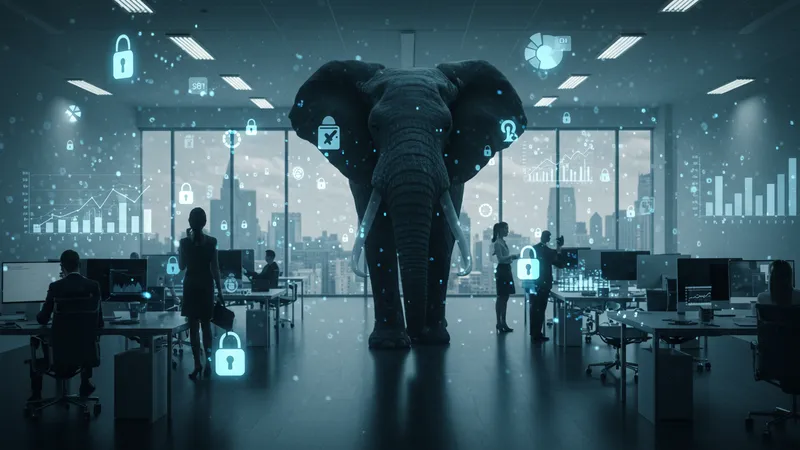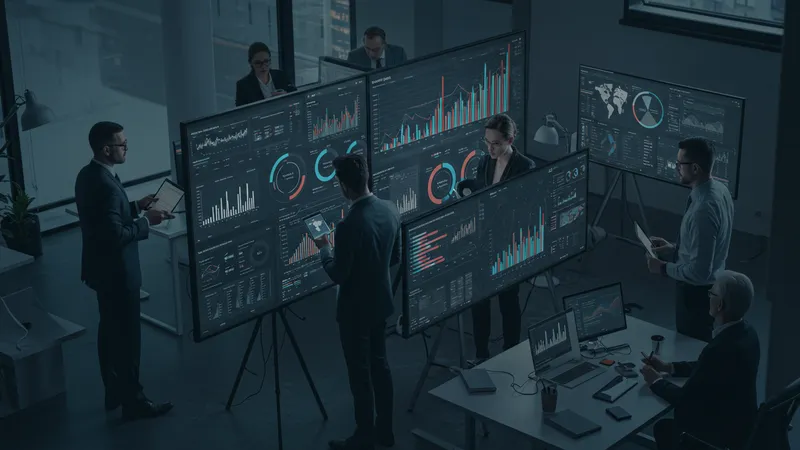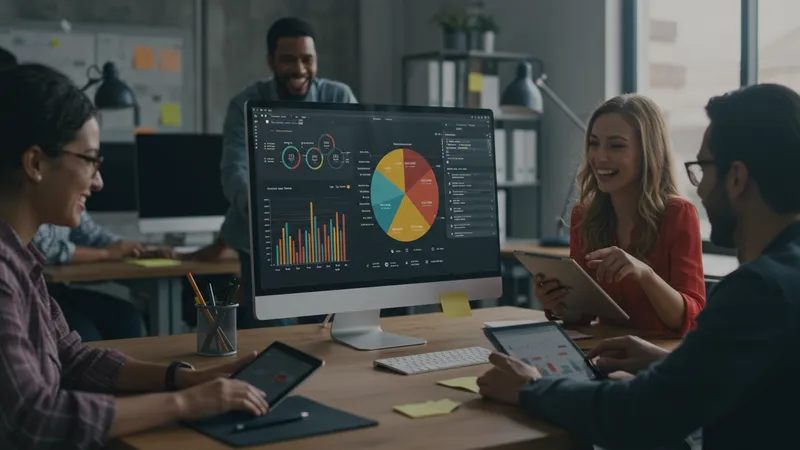


Did you know that more than 90% of the world's data was created in the last two years alone? This explosive growth in data is reshaping industries overnight.
In a world driven by information, understanding data has never been more critical. As businesses compete to leverage insights, knowing which tools to use can mean the difference between success and stagnation.

Many believe they are tapping into the power of data, but few truly understand the depths these tools can uncover. Power BI, for example, doesn’t just visualize data—it can predict outcomes with impressive accuracy. That’s the beauty and complexity of modern data platforms. But that’s not even the wildest part...
Tableau has been known to turn bland numbers into compelling stories. Its sophisticated algorithms allow users to drag and drop data to see real-time changes. Companies using Tableau have witnessed groundbreaking shifts in strategy and execution. But what happens next shocked even the experts...
Stay tuned as we uncover hidden agendas, surprising uses, and the secret features of data tools that everyone is talking about. The next revelation might just change everything you thought you knew about data analysis.
In the digital age, access to data has become as essential as oxygen. What most people don’t realize is the complex web of permissions, access times, and data rights involved. Companies spend millions annually just to ensure they have the right data at the right time.

The privileged access to vast data sets means power. Many insider secrets are locked within company-specific databases that remain hidden from the public eye. It’s not just about quantity but quality and relevance. Here's where the real game is played, where winners and losers emerge in the marketplace.
A closer examination reveals a paradox: while data is more powerful than ever, managing permissions is a bottleneck stifling innovation. Businesses must navigate a labyrinth of security protocols to harness insights. It’s a balancing act of power and responsibility. But there’s one more twist…
The democratization of data access is on the verge of breaking the barriers, thanks to developments in decentralized networks. This breakthrough threatens to overturn the traditional structures, promising insights to those who never had them before. What you read next might change how you see this forever.
When investing in data tools, most organizations focus on the direct costs of licensing and subscriptions. However, the hidden expenses often lie beneath the surface, silently eroding budgets. From training costs to data storage fees, the total cost of ownership can indeed be staggering.

Consider the case of a mid-sized company that integrated Tableau; the unforeseen expenses were nearly 30% higher than initially budgeted. This was largely due to the need for extensive staff training and system customizations. It's a cautionary tale for any organization looking to dip its toes into the data realm.
Even more startling is the growing trend of companies requiring specialized roles such as data scientists and analysts. These experts command hefty salaries and can be the difference between success and chaos. Their scarcity makes them a hot commodity in the job market, driving up the cost considerably.
But there's another angle that often goes unnoticed: opportunity costs. As companies become overly consumed with data setup and management, they risk losing focus on core business operations. What happens when data becomes a distraction rather than an asset? It’s the unspoken reality, and it’s unfolding faster than anyone anticipated.
Mere numbers can be overwhelming, but visualization transforms them into digestible and actionable insights. What’s surprising is how this simple shift can impact decision-making. Organizations with effective data visualization strategies are 77% more likely to achieve business objectives.

Tools like Power BI and Tableau shine in this arena, offering rich, interactive visuals that bring data to life. They empower stakeholders at all levels to explore trends and identify potential red flags before they spiral into major issues. The clarity that visualization provides is a competitive edge that cannot be overstated.
Beyond the evident visual appeal, the strategic implications are profound. Visualization not only aids in comprehension but also in communicating complex data to non-technical audiences. This results in faster decision-making processes, significantly improving time-to-market strategies.
But visualization is just the tip of the iceberg. The real magic lies in predictive analytics, where data meets foresight, providing unprecedented levels of foresight into future trends and behaviors. But the most surprising part about this transformation is yet to come...
As data collection becomes more pervasive, privacy concerns loom larger than ever. Shockingly, a study found that 60% of companies have experienced a data breach in the past year alone. The repercussions are catastrophic, from legal penalties to loss of customer trust.

Despite these risks, data-driven strategies continue to be a priority, pushing businesses to balance privacy with insights. Predictive tools and machine learning are particularly scrutinized for their usage and storage of sensitive information. It’s a fine line to walk on the path to innovation.
The rise of privacy regulations, like GDPR, has become a catalyst for change, forcing companies to reconsider their data practices. This shift highlights the importance of transparency and accountability in a data-rich world. Adapting to these rules is not just a compliance issue but a strategic advantage.
Yet the landscape is constantly evolving. As restrictions increase, alternative methods of capturing and analyzing data are emerging. These advancements promise to disrupt traditional practices, but at what cost? The balance of power could shift dramatically, and what’s around the corner could redefine privacy itself.
Predictive analytics is no longer a futuristic concept—it's a present-day reality with immense impact. Leveraging historical data, businesses can anticipate trends and make proactive decisions, often leading to astonishing results. Reports show productivity gains of up to 33% across various industries.

Tools like Power BI enable users to uncover patterns in data that were previously invisible to the human eye. This shows how technology is redefining the realm of possibilities, providing insights that can steer businesses towards unprecedented growth.
Despite its advantages, predictive analytics raises ethical questions regarding fairness and bias. How these tools evaluate and favor certain data points could lead to unintended exclusions or disadvantages, needing attention from policymakers and tech developers alike.
Even so, the allure of predictive capabilities continues to captivate leaders worldwide. Their quest to stay ahead of the curve by predicting consumer behaviors illustrates the competitive battlegrounds of tomorrow. But is that all there is to this narrative? What lies beyond the horizon is something even experts are eager to explore.
Gone are the days when centralized data storage was the norm. Enter decentralized networks, heralded as the future of data management. By eliminating single points of failure, these systems promise robustness and enhanced data integrity.

This revolution is quietly transforming industries, with blockchain technology leading the charge. Immutable records and secure transactions redefine how data is trusted and exchanged. This paradigm shift hints at greater democratization and less reliance on siloed data environments.
However, integrating decentralized systems within traditional frameworks is fraught with challenges. The actionable insights from these networks need seamless extraction while ensuring interoperability with existing systems, a technological hurdle many are racing to overcome.
The potential is tantalizing—a world where organizations and users coexist in a fully transparent ecosystem, free from traditional gatekeepers. The stakes are high, and as the journey unfolds, the implications promise to reshape the world we know. The upcoming pages reveal methodologies that push the boundaries further than ever imagined...
In the fast-paced business environment, real-time analytics stand out as a game-changer. They allow decision-makers to act swiftly, often against competitors still grappling with outdated, static reports. This capability is reshaping competitive dynamics globally.

The beauty of real-time analytics lies in its responsiveness. Tools like Tableau empower leaders with an immediate snapshot of operations, sales, and market conditions, providing a critical edge in decision-making. The speed of adaptation they offer can define success.
This velocity, however, demands rigorous data governance and quality checks. As the volume of live data grows, so does the complexity in ensuring accuracy. Yet the rewards far exceed the risks, with businesses reporting unexpected boosts in efficiency and performance.
As organizations strive for precision, the pace at which analytics evolve will influence entire sectors. But what if the whole concept of analytics is set to evolve? The transformative changes brewing might just unveil a realm where decisions are not just informed but intelligently predicted...
Data is dispersed across countless systems, creating a daunting challenge for businesses: integration. Harmonizing this data to serve a unified purpose requires advanced tools and strategies, often underestimated during initial planning phases.

The dream of seamless data integration is, for many, still out of reach. Issues often arise from incompatible data formats or outdated systems that refuse collaboration. It’s a problematic scenario, costing organizations both time and resources, while stalling innovation.
Yet, the pursuit of a single source of truth drives technological investments, with many turning to platforms offering seamless integration solutions. These tools, however, require an overhaul in workflow and often, an entire cultural shift towards data-centric strategies.
The journey is rife with trial and error, but the possibility of connecting in a way never before established is a tantalizing promise. As integration strategies develop, the true potential of comprehensive and coherent data is only just beginning to reveal itself. What's next may forever change integration paradigms.
Artificial Intelligence has stepped into the spotlight within the data analysis world, offering untapped potential that many are just beginning to explore. The combination of AI with big data translates into smarter, faster, and more inclusive analytics across industries.

AI’s capacity to process vast amounts of data with speed and accuracy surpasses human abilities. This allows for complex pattern recognition and the generation of meaningful insights that would otherwise remain hidden. Its potential to redefine traditional analysis cannot be overstated.
However, the application of AI in data still faces hurdles, such as the need for clean, high-quality data and robust infrastructure to support AI algorithms. Companies that overcome these barriers stand to gain a formidable competitive advantage.
The next frontier? AI guiding data analysts not just to current trends, but towards predicting future innovations and strategies. This new epoch in data analysis is coming, and it’s set to revolutionize the way information drives decision-making. But could there be even more remarkable advancements on the horizon?
One of the major shifts in data tools has been the focus on intuitive, user-friendly interfaces. A decade ago, data analysis was the domain of specialists. Today, tools are crafted for accessibility, democratizing data understanding across all company levels.

Platforms like Tableau have spearheaded this change, offering drag-and-drop functionalities that require zero coding knowledge. By empowering non-technical users, these tools allow for a more inclusive approach to data analysis.
While increased accessibility improves organizational insight, it poses challenges regarding data governance and security. Ensuring that democratization doesn’t compromise data integrity is a fine line that businesses must navigate carefully.
Yet, the emphasis on user-centric design shows no signs of slowing. As our global economy becomes more data-driven, intuitive design will remain crucial in bridging the gap between data complexity and human comprehension. This ongoing evolution likely holds even more surprises in store, reshaping workplace dynamics more swiftly than anticipated.
The rise of automation within data analytics signifies a groundbreaking shift in how insights are derived and utilized. Automating data processes, from collection to cleansing, reduces human error and frees up valuable resources for strategic planning.

Businesses that adapt to automation have reported efficiency gains and minimized redundancy. Tools now provide end-to-end solutions, automating not just workflows but decision-making processes as well, signaling a new era in data-driven business practices.
Such widespread automation does pose its challenges. Questions surrounding the accuracy of automated insights, coupled with the fear of job displacement, bring to light the complex implications of this shift. How these are faced will define the next decade of data progression.
Looking ahead, the potential for self-learning systems to outperform their human predecessors proffers a future where human creativity and machine efficiency coexist harmoniously. The real impact? It promises far-reaching transformations more extraordinary than computers replacing typewriters...
The evolution of data tools is far from over; in fact, it’s accelerating. Integrations with cutting-edge technologies, such as augmented reality and quantum computing, are on the horizon; technology that once seemed like science fiction is rapidly becoming reality.

Looking forward, data's role in business strategy will undoubtedly expand. Companies that effectively harness these tools position themselves well to lead their industries, leveraging superior knowledge and agility to conquer new frontiers.
As the landscape continues to evolve, so does the importance of ethical considerations and responsible data usage. Navigating these murky waters will require courage, innovation, and a commitment to creating value not just for businesses, but for society as a whole.
With the paradigm shifts underway, staying informed and adaptive is vital. Are you ready to see what lies ahead? The culmination of these developments holds untold potential, bound to reshape your understanding of the data-driven future that awaits.
The journey through data tools unveils an enlightening truth: our world is on the brink of a profound transformation. As we leverage and integrate these powerful insights, the way we make decisions will never be the same. Empowerment through data is not just a trend—it’s the new reality. But there’s more: share this revelation and watch as the world around you begins to see data through a new, empowering lens.